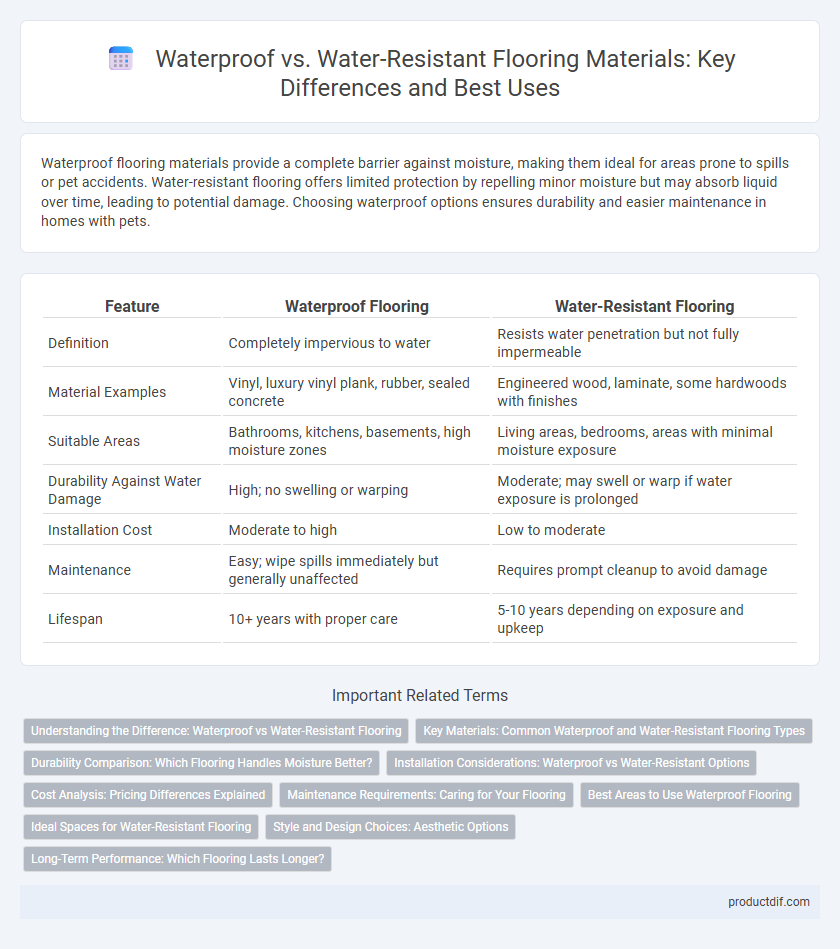Waterproof flooring materials provide a complete barrier against moisture, making them ideal for areas prone to spills or pet accidents. Water-resistant flooring offers limited protection by repelling minor moisture but may absorb liquid over time, leading to potential damage. Choosing waterproof options ensures durability and easier maintenance in homes with pets.
Table of Comparison
| Feature | Waterproof Flooring | Water-Resistant Flooring |
|---|---|---|
| Definition | Completely impervious to water | Resists water penetration but not fully impermeable |
| Material Examples | Vinyl, luxury vinyl plank, rubber, sealed concrete | Engineered wood, laminate, some hardwoods with finishes |
| Suitable Areas | Bathrooms, kitchens, basements, high moisture zones | Living areas, bedrooms, areas with minimal moisture exposure |
| Durability Against Water Damage | High; no swelling or warping | Moderate; may swell or warp if water exposure is prolonged |
| Installation Cost | Moderate to high | Low to moderate |
| Maintenance | Easy; wipe spills immediately but generally unaffected | Requires prompt cleanup to avoid damage |
| Lifespan | 10+ years with proper care | 5-10 years depending on exposure and upkeep |
Understanding the Difference: Waterproof vs Water-Resistant Flooring
Waterproof flooring prevents water from penetrating its surface entirely, making it ideal for areas exposed to frequent moisture like bathrooms and basements. Water-resistant flooring can withstand minor spills and humidity but may sustain damage with prolonged exposure to water. Choosing between waterproof and water-resistant options depends on the specific moisture exposure and durability requirements of the space.
Key Materials: Common Waterproof and Water-Resistant Flooring Types
Vinyl and ceramic tile are common waterproof flooring materials known for their impermeability and durability in wet environments. Engineered hardwood and laminate flooring often feature water-resistant properties, allowing them to withstand spills with some protective coatings but not full water immersion. Waterproof flooring typically uses synthetic materials or sealed surfaces, while water-resistant types rely on treatments that delay moisture penetration.
Durability Comparison: Which Flooring Handles Moisture Better?
Waterproof flooring, typically made from materials like vinyl or ceramic tile, offers superior durability against moisture by completely preventing water penetration, making it ideal for areas prone to frequent spills or flooding. Water-resistant flooring, such as engineered hardwood or laminate, resists water damage but may allow some moisture to seep through over time, potentially leading to warping or swelling. For long-term moisture exposure, waterproof flooring outperforms water-resistant options in maintaining structural integrity and appearance.
Installation Considerations: Waterproof vs Water-Resistant Options
Waterproof flooring requires precise installation to ensure watertight seams, often involving specialized underlayment and moisture barriers, making it ideal for high-moisture areas like bathrooms and basements. Water-resistant flooring, while easier to install with standard underlayment, offers limited protection against prolonged water exposure and is better suited for spaces with occasional spills. Considering the installation requirements and environment helps determine whether waterproof or water-resistant flooring best protects subfloors and maintains durability.
Cost Analysis: Pricing Differences Explained
Waterproof flooring materials typically come at a higher initial cost due to advanced sealing technologies and durable materials like vinyl or ceramic, which prevent water penetration entirely. Water-resistant options, such as treated hardwood or laminate, offer a more affordable price point but require maintenance and replacement sooner because they only repel moisture temporarily. Investing in waterproof flooring can reduce long-term expenses by minimizing damage-related repairs and replacements, offsetting their upfront premium.
Maintenance Requirements: Caring for Your Flooring
Waterproof flooring requires minimal maintenance as it resists water penetration, preventing warping, staining, and mold growth, making it ideal for high-moisture areas. Water-resistant flooring needs more attentive care to avoid prolonged exposure to standing water, including prompt cleaning and using protective sealants to maintain its durability. Regular upkeep, such as drying spills promptly and avoiding harsh chemicals, ensures both types maintain their appearance and functionality over time.
Best Areas to Use Waterproof Flooring
Waterproof flooring is ideal for high-moisture areas such as bathrooms, kitchens, laundry rooms, and basements where water exposure is frequent and prolonged. Materials like luxury vinyl planks, ceramic tiles, and waterproof laminate provide durable protection against spills, humidity, and occasional flooding. Choosing waterproof flooring in these locations prevents water damage, mold growth, and warping, ensuring long-lasting performance and easy maintenance.
Ideal Spaces for Water-Resistant Flooring
Water-resistant flooring is ideal for areas with occasional moisture exposure such as kitchens, laundry rooms, and entryways, where spills and humidity are common but not constant. Materials like luxury vinyl plank, laminate with water-resistant coatings, and engineered hardwood offer protection against minor water incidents while maintaining aesthetic appeal. These floors balance durability and moisture defense, making them suitable for spaces prone to dampness but without direct water immersion.
Style and Design Choices: Aesthetic Options
Waterproof flooring offers a wider range of design options, including realistic wood, stone, and tile looks that maintain their appearance in wet areas. Water-resistant flooring, while protective against spills, typically features more limited patterns and textures suited for low-moisture environments. Choosing waterproof materials enhances aesthetic flexibility for kitchens, bathrooms, and basements without compromising style.
Long-Term Performance: Which Flooring Lasts Longer?
Waterproof flooring, such as vinyl planks and ceramic tiles, offers superior long-term durability by completely preventing water penetration, reducing risks of warping, mold, and structural damage. Water-resistant options like laminate and engineered wood provide moderate protection, but prolonged exposure to moisture can lead to swelling and deterioration over time. For extended longevity in high-moisture environments, waterproof flooring materials consistently outperform water-resistant alternatives in maintaining structural integrity and appearance.
Waterproof vs Water-Resistant Infographic

 productdif.com
productdif.com